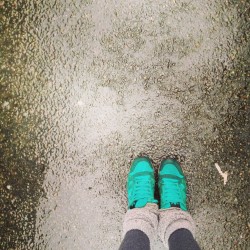
Warning: F-bombs up ahead.
What to expect during the aftermath of a suicide attempt is not talked about enough, in my opinion.
Over the last 23 months—as I’ve been stepping out the other side of my attempt—I’ve spent so much time on Google, searching for some sort of step-by-step account of what to expect along this journey. I’ve wanted someone to tell me how to do this, and how to make this shit a little easier.
The feelings that have followed my attempt are the things I’ve most wanted advice on, and guidance with. They feel so clear, vivid and recognisable, beneath the messiness of this process—it’s taken a long while to be able to say that, but they’ve become more and more familiar and noticeable to me, as the months have gone on.
“They must be feelings that everyone who attempts suicide feels, at some point, some time, just perhaps in a different order or time-frame to when I feel mine.” I often tell myself.
Perhaps not, but self-talking this way reassures me and brings me hope that I’m not alone in this process.
My feelings have been an outfit I’ve been getting to know, wear, put together (consciously or subconsciously), and find a comfortable size in, over this time. What they’ve looked like has always looked a little different—sequins, holes, rips, stains, badges—but generally, the same feelings have been the theme of my internal wardrobe.
Shame, guilt, hatred (for myself), anger, sorrow and heartbreak, fear, relief and gratitude, have become my clothes.
Shame—the winter coat
The thick coat of shame has been the reason I’ve spent so many hours tucked inside my bedroom or sitting on a bench beside a tree, sweating beneath the heavy leather and faux-fur lining. Avoiding calls and resisting the desire to invite friends to hang-out, is generally always because of this sneaky motherfucker. It’ll dress me with itself regardless of whether it’s summer or winter outside, or whether I’m even going outside.
Shame is the only feeling that takes me back to a place of wondering whether I should be in the world (but never to the extent in which I felt this when I overdosed). I can easily slip into feeling pretty fucking convinced that I don’t deserve to be here, because of what I did and where I now find myself. Thankfully, though, there’s a gentleness, a warmth, and an openness within my heart that pipes up and says, “You do”, in these moments.
Sometimes self-talk undresses me, but generally, the only way to rid myself of the coats weight and toxicity, is to connect—to talk and share and reality check. A while ago I asked a friend, “How are you still friends with me, after what I did?” Her reply brought me out of a months worth of coat-wearing.
The connection doesn’t have to be about what happened. Any kind of connection—person, animal, shrub—reminds me of love and hope, and removes the coat.
Guilt—the trousers
When I think about what I did—what my friends went through because of it, and what I put myself and my body through—my forehead wrinkles, my stomach twists, and guilt smothers my legs with lead trousers.
I can’t move.
My guilt feels too big to even type, let alone speak about fully. I fear its presence. I fear my critic’s theories of selfishness—the fact that I thought “I had the right to do something like that…”—in case they’re true.
Soothing self-talk slightly lightens the guilt, as does reading stories from others who have attempted, online—I realise it’s not just me in the world that has done this, tried this. But even within this, there’s guilt around the judgement I feel when reading these stories—judgements that they did something like that, a disbelief that I did it, too.
These weigh about 15 stone. I used to slip them on, and tread through me, whenever the internal call came. Hate was the sole, disgust the shoelaces. Hatred for what I did and disgust that I now fall under the bracket of a suicide attempt survivor.
Now I can witness, distract myself, and realise the sound these shoes make, isn’t the only sound I need to listen to—listening to the ever-growing love, respect, and compassion, I have for myself soothes the hate.
As does connection and a reminder that I’m still loved, regardless of my attempt.
Anger—the vest
My anger has felt like a sparkly, superwoman vest, that I can rip my shame-coat open, and find. I’ve felt fear around how huge it’s seemed, and how fierce it’s seemed. I’ve struggled to trust it and trust myself with it.
There’s been anger around the fact I even got to a place of wanting to, and thinking I needed to, overdose. Anger that I felt so alone, and couldn’t see the love I had around me.
I feel livid with the responsibility, trauma and abuse I experienced in my youth and early adulthood, and the wondering whether an overdose would never have happened had this not been part of my story. I feel a sickening anger that it’s what I witnessed my mum do so often, and a wondering whether that’s what made me have it as an option.
I’ve felt, and continue to feel, rage and shock around the way Western Medicine dealt with my attempt.
I’ve felt anger that noone stopped me, and that I didn’t stop myself.
I’m learning to find this vest in a size that I feel comfortable with. The more I let it be here, the more empowered, healthy I feel. My anger is a fire that makes me realise I, 100%, want to be here.
Fear—the scarf
My fear has felt like I’ve been trying to wear a silk scarf, wrapped around my neck in gale-force winds—it’s flown around my face, blinding and shocking me in the gusts. It’s left reality and the truth seemingly impossible to find, or see.
Trauma has stormed my system—a wild scarf, flying above my head—from all that I experienced before, during, and after my attempt. My scarf’s felt knotted with worry and a haunting fear that the overdose might happen again, and a concern about being ‘too much’ in my healing process—I often halt my need to talk and share about it, due to this.
There’s been the what-if’s, patterned deeply into my fear:
What if I’d waited longer to call the ambulance?
What if I hadn’t made the call, and I’d been found?
What if my body hadn’t performed a miracle (the words of the nurses) and healed so quickly, without needing to switch my liver for another one?
What if my therapist hadn’t been there to sit with me, during the early stages of waking up?
What if my friends hadn’t have been so incredibly, mind-blowingly, supportive?
What if I’d called for help before I decided to overdose?
What if it had worked—what if I’d not lived through it?
These fears are beginning to soften with time—instead of my scarf seemingly stripping me of my sanity, I can now wrap myself in it to bring comfort and reassurance that those what-ifs never happened, and never will.
I’m safe.
Heartbreak and sorrow—the belt
The heartbreak of what I experienced and what I wanted to experience, is like a lead belt around my waist. The sorrow for my younger self weights 100 tonnes, when I realise I tried to kill myself.
I could throw up, or sob for 100 years.
She wanted to die—she couldn’t see any other way out. She thought she couldn’t, and shouldn’t, be here, on the Earth. She didn’t know/couldn’t feel, that there were people to catch her, help her, support her, bring her hope. She didn’t know how to connect with the part I have within myself, that can offer these things, too.
There are no other words, only tears and disbelief.
Over the last 23 months, I’ve had so many waves of realising:
I’m alive.
I survived.
I’m here.
I almost died.
Each time these waves hit, I feel a sudden nakedness. All my clothes have fallen off—I’m exposed and I’m here. I lose my breath, catch it again, and breathe deep into my belly, overwhelmed with relief and gratitude that I made the call that saved my life.
Each time, I’ve longed to reach out, find someone, and tell them. I’ve wanted to shout it from the rooftops—the world needs to know: I’m alive! I survived!
I’m still trying this outfit on, and sometimes refuse to acknowledge that I’m actually wearing it and am having the feelings, but when I do look myself in my mirror, I find I’m not quite so over-sized or in-too-tight. I’m increasingly realising that within these feelings, lies a beautiful healing, and a deep connection with—and understanding of—myself that’s so unique to this process.
I sometimes gently revisit the event and find an understanding of why it happened. I’ve begun to cultivate forgiveness for myself that it did, and I’m discovering a trust and genuine belief that it’ll never happen again.
I’m learning to love myself with whatever I’m wearing, and whatever I’m not.
And I’m also slowly taking hold of the fact that I don’t need to figure it all out.
This is Part Three of a series.
Read Part One—Waking Up From a Dream—here.
Read Part Two—I Can’t Predict The Future—here.
Read Part Four—My Life After—here.
Love elephant and want to go steady?
Sign up for our (curated) daily and weekly newsletters!
Editor: Catherine Monkman
Photo: Carus Ionut; Amani Omejer; elephant archives













Read 1 comment and reply